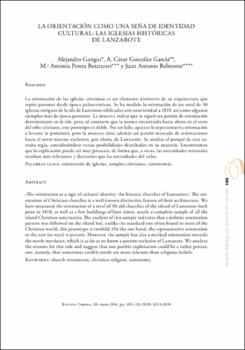La orientación como una seña de identidad cultural: las iglesias históricas de Lanzarote
Fecha
2014Resumen
La orientación de las iglesias cristianas es un elemento distintivo de su arquitectura que repite patrones desde época paleocristiana. Se ha medido la orientación de un total de 30 iglesias antiguas de la isla de Lanzarote edificadas con anterioridad a 1810, así como algunos ejemplos más de época posterior. La muestra indica que se siguió un patrón de orientación determinante en la isla, pero, al contrario que la norma encontrada hasta ahora en el resto del orbe cristiano, este prototipo es doble. Por un lado, aparece la representativa orientación a levante (o poniente), pero la muestra tiene además un patrón marcado de orientaciones hacia el norte-noreste exclusivo, por ahora, de Lanzarote. Se analiza el porqué de esta extraña regla, considerándose varias posibilidades desechadas en su mayoría. Encontramos que la explicación puede ser muy prosaica, de forma que, a veces, las necesidades terrenales resultan más relevantes y decisorias que las necesidades del culto. The orientation of Christian churches is a well-known distinctive feature of their architecture. We have measured the orientation of a total of 30 old churches of the island of Lanzarote built prior to 1810, as well as a few buildings of later times, nearly a complete sample of all the island Christian sanctuaries. The analysis of this sample indicates that a definite orientation pattern was followed on the island but, unlike the standard one often found in most of the Christian world, this prototype is twofold. On the one hand, the representative orientation to the east (or west) is present. However, the sample has also a marked orientation towards the north-northeast, which is as far as we know a pattern exclusive of Lanzarote. We analyze the reasons for this rule and suggest that one posible explanation could be a rather prosaic one, namely, that sometimes earthly needs are more relevant than religious beliefs.





